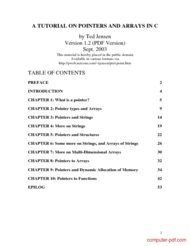A on pointers and arrays in c Tutorial in PDF
TABLE OF CONTENTS
- CHAPTER 1: What is a pointer?
- CHAPTER 2: Pointer types and Arrays
- CHAPTER 3: Pointers and Strings
- CHAPTER 4: More on Strings
- CHAPTER 5: Pointers and Structures
- CHAPTER 6: Some more on Strings, and Arrays of Strings
- CHAPTER 7: More on Multi-Dimensional Arrays
- CHAPTER 8: Pointers to Arrays
- CHAPTER 9: Pointers and Dynamic Allocation of Memory
- CHAPTER 10: Pointers to Functions
Learning the A tutorial on pointers and arrays in c
Beginner programmers in the C programming language are the target audience for this document, as its primary focus is on pointers. Everything that is included in this document is hereby made available in the public domain. My only request is that this content be used as a teaching aid in a classroom setting, which means that all of the chapters, as well as the preface and the introduction, must be covered. This tutorial's objective is to provide those who are just starting out with an introduction to pointers and how they should be used. To get the most out of the information in the article, I think it's important for the user to be able to run the code in the different listings.
It is highly recommended that readers carry out this activity because doing so will assist in better comprehending the material. The study of strings is helpful in furthering our understanding of the relationship that exists between pointers and arrays. The memory allocating function (such as malloc() or calloc(), etc.) will return a pointer after it has successfully allocated memory. Arrays are just one of the many types of data objects that can have pointers "pointed" at them in this way. In this section, I will go over a variety of techniques for dynamically allocating space for arrays of integers that are two-dimensional.
Each invocation of the malloc() function results in the creation of additional overhead. In addition, declarations of function pointers can be made in C programs. The array is analyzed by the algorithm from the second to the last element, and a comparison is made between each element and the one that came before it. The procedure is repeated an amount of times equal to the number of elements minus one, and the end result is a sorted array.
| Level : | Intermediate |
| Created : | April 9, 2014 |
| Size : | 205.09 KB |
| File type : | |
| Pages : | 53 |
| Author : | Ted Jensen |
| Downloads : | 6608 |
